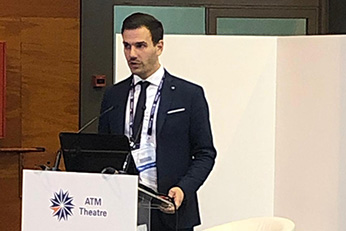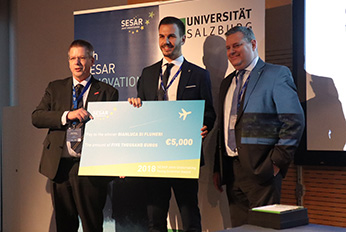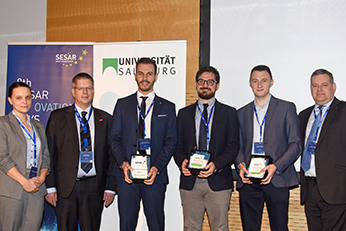Air traffic control is reputed as one of the five most stressful professions there is. Addressing the mental workload of controllers is therefore an important area of SESAR research and innovation and one that Gianluca di Flumeri and his colleagues have been investigating over the past 10 years. In 2018, Di Flumeri received the SESAR Young Scientist award for a ground-breaking method for evaluating controllers’ mental workload using brain activity measurements. In this article he explains his research trajectory so far and why researching the human factor in ATM is fundamental for the safety, efficiency and sustainability of aviation.
What is your background and how did you get involved in air traffic management research?

On the surface of it, my research and expertise seem far from the aerospace and air traffic management domains. I am a biomedical engineer by profession, having graduated from the Sapienza University of Rome, and now hold a PhD in biophysics.
I suppose my transition towards ATM came with my master’s thesis, which I conducted at the Industrial Neuroscience Labs, led by Professor Fabio Babiloni at Sapienza University. There my research was focused on investigating human mental states, such as mental workload, stress, attention, by analysing neurophysiological signals related to brain activity and other body reactions. In particular, our vision consisted (and still consists) in applying such a neuroscientific methodology outside the research laboratories, in all those operational situations where predicting a user’s mental status and his/her performance could have a positive impact.
When starting my PhD career (in 2014), Professor Babiloni’s team was involved at that time in a SESAR exploratory research called “NINA - Neurometrics Indicators for ATM”. The project focused on neurometrics, which measured the neurophysiological signals of air traffic controllers’ brains in order to analyse controller mental workload and cognitive training. I was immediately drawn to this intriguing topic, which has become the focus of my research ever since!
Why do you feel researching ATM is so important to European society and economy?
Our skies will undoubtedly remain an important mode of transportation in the future, not only for the mobility of people, but also in terms of trading and other services. Just consider drones and the potential they can offer for all types of operations, including shipping, surveillance and maintenance. Although ATM service is very much a hidden part of the aviation chain, its role is crucial to ensure safety, efficiency and sustainability. Therefore, research in ATM is fundamental, especially given the expected “aviation boom”, in order to guarantee the highest levels of safety, efficiency, ecology, as well as operators’ health - Air traffic control has been ranked among the five most stressful professions.
You were awarded the 2018 SESAR Young Scientist Award for your work on the development of passive brain-computer interfaces for air traffic control. Can you tell us a bit about that work?

In safety-critical industries like aviation, the human factor is one of the most important and at the same time least controllable factors. An error, whether it is a wrong procedure or a non-detected emergency, can have very dramatic consequences. Most of such human errors are caused by mental impairments, i.e. for instance too high workload or stress, loss of situational awareness, fatigue, and so on. Traditionally, these human factor concepts were evaluated through subjective analyses or inferred through system data (performance measurements), however these approaches are weak due to the lack of data during real-time operations. A neurophysiological approach overcomes these limitations, since it is intrinsically objective, allowing analyses to be made during operations without interfering with the controller’s work. Furthermore, and this is the most ground-breaking aspect of my work, after validating specific neurometrics of workload and concentration levels with controllers, we employed them as a basis to trigger adaptive automation support solutions within the controller’s human machine interface. For instance, when the system detected a potential mental overload situation for the controllers, the level of automation of the system was increased to help them. In cases where the level of vigilance showed to decrease, the automation level was lowered in order to keep the controller “in-the-loop”.
What has winning the Young Scientist Award meant for your career development?
The SESAR Young Scientist Award has been a really important milestone, not only for me but for the whole team with which I share research, objectives and ambitions. The research work is a really arduous activity, usually few impressive outcomes result from a very large and long work, and seldom it is properly recognised. Therefore, this award has been first of all a great stimulus for my future work. Also, it has been even more gratifying to see that my research and work in previous SESAR projects such as NINA, STRESS, MOTO and MINIMA are promoting follow-up research activities in SESAR.
Are there developments taking place in other sectors that we should be closely following or even replicating?

I am really convinced that the aerospace domain is a driving force for applied scientific research: knowledge from several fields is already converging within it, so that maybe it is easier to say how this sector could be an example for the others. Anyhow, I think that the large field of data mining and its recent evolution in the concepts of Internet-of-Things and artificial intelligence, would undoubtedly become an important resource to enhance ATM service performance, and its standards in terms of safety and efficiency.
What advice would you give other researchers starting out or interested in the field?
I think I am a great example of how much the aerospace/air traffic management field is multidisciplinary, thus my suggestion for my colleagues is “please do not think that this field is not looking for you”. ATM research brings together an amazing mixture of knowledge, from psychology and life sciences to pure technological fields. Research in this field is really intriguing and at the forefront and I encourage researchers from all domains to give it a go!
